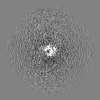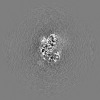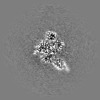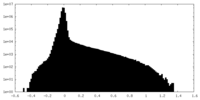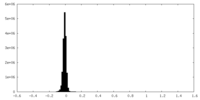+ Open data
Open data
- Basic information
Basic information
| Entry |  | ||||||||||||||||||||||||||||||||||||
|---|---|---|---|---|---|---|---|---|---|---|---|---|---|---|---|---|---|---|---|---|---|---|---|---|---|---|---|---|---|---|---|---|---|---|---|---|---|
| Title | Cryo-EM structure of PI3Kalpha in complex with compound 16 | ||||||||||||||||||||||||||||||||||||
 Map data Map data | |||||||||||||||||||||||||||||||||||||
 Sample Sample |
| ||||||||||||||||||||||||||||||||||||
 Keywords Keywords | Phosphoinositide 3-kinase / drug target / ligand / binding pocket / chemical scaffold / STRUCTURAL PROTEIN | ||||||||||||||||||||||||||||||||||||
| Function / homology |  Function and homology information Function and homology informationperinuclear endoplasmic reticulum membrane / regulation of toll-like receptor 4 signaling pathway / response to muscle inactivity / phosphatidylinositol kinase activity / regulation of actin filament organization / negative regulation of actin filament depolymerization / response to L-leucine / positive regulation of focal adhesion disassembly / response to butyrate / 1-phosphatidylinositol-3-kinase regulator activity ...perinuclear endoplasmic reticulum membrane / regulation of toll-like receptor 4 signaling pathway / response to muscle inactivity / phosphatidylinositol kinase activity / regulation of actin filament organization / negative regulation of actin filament depolymerization / response to L-leucine / positive regulation of focal adhesion disassembly / response to butyrate / 1-phosphatidylinositol-3-kinase regulator activity / phosphatidylinositol 3-kinase regulator activity / IRS-mediated signalling / positive regulation of endoplasmic reticulum unfolded protein response / phosphatidylinositol 3-kinase activator activity / interleukin-18-mediated signaling pathway / T follicular helper cell differentiation / phosphatidylinositol 3-kinase complex / PI3K events in ERBB4 signaling / cellular response to hydrostatic pressure / phosphatidylinositol 3-kinase regulatory subunit binding / autosome genomic imprinting / myeloid leukocyte migration / regulation of cellular respiration / neurotrophin TRKA receptor binding / Activated NTRK2 signals through PI3K / cis-Golgi network / negative regulation of fibroblast apoptotic process / Activated NTRK3 signals through PI3K / transmembrane receptor protein tyrosine kinase adaptor activity / ErbB-3 class receptor binding / phosphatidylinositol 3-kinase complex, class IB / positive regulation of protein localization to membrane / vasculature development / 1-phosphatidylinositol-4-phosphate 3-kinase activity / Signaling by cytosolic FGFR1 fusion mutants / Co-stimulation by ICOS / RHOD GTPase cycle / cardiac muscle cell contraction / phosphatidylinositol 3-kinase complex, class IA / Nephrin family interactions / RHOF GTPase cycle / kinase activator activity / Signaling by LTK in cancer / anoikis / phosphatidylinositol-3-phosphate biosynthetic process / relaxation of cardiac muscle / positive regulation of leukocyte migration / Signaling by LTK / MET activates PI3K/AKT signaling / PI3K/AKT activation / 1-phosphatidylinositol-4,5-bisphosphate 3-kinase activity / negative regulation of stress fiber assembly / RND1 GTPase cycle / phosphatidylinositol-4,5-bisphosphate 3-kinase / positive regulation of filopodium assembly / RND2 GTPase cycle / RND3 GTPase cycle / vascular endothelial growth factor signaling pathway / phosphatidylinositol 3-kinase / growth hormone receptor signaling pathway / insulin binding / 1-phosphatidylinositol-3-kinase activity / Signaling by ALK / PI-3K cascade:FGFR3 / RHOV GTPase cycle / RHOB GTPase cycle / Erythropoietin activates Phosphoinositide-3-kinase (PI3K) / natural killer cell mediated cytotoxicity / GP1b-IX-V activation signalling / negative regulation of macroautophagy / PI-3K cascade:FGFR2 / response to dexamethasone / PI-3K cascade:FGFR4 / phosphatidylinositol-mediated signaling / PI-3K cascade:FGFR1 / RHOC GTPase cycle / RHOJ GTPase cycle / intracellular glucose homeostasis / negative regulation of osteoclast differentiation / phosphatidylinositol phosphate biosynthetic process / Synthesis of PIPs at the plasma membrane / RHOU GTPase cycle / RET signaling / CDC42 GTPase cycle / negative regulation of anoikis / PI3K events in ERBB2 signaling / Interleukin-3, Interleukin-5 and GM-CSF signaling / PI3K Cascade / insulin receptor substrate binding / intercalated disc / T cell differentiation / RHOG GTPase cycle / negative regulation of cell-matrix adhesion / extrinsic apoptotic signaling pathway via death domain receptors / regulation of multicellular organism growth / protein kinase activator activity / CD28 dependent PI3K/Akt signaling / RHOA GTPase cycle / Role of LAT2/NTAL/LAB on calcium mobilization / RAC2 GTPase cycle Similarity search - Function | ||||||||||||||||||||||||||||||||||||
| Biological species |  Homo sapiens (human) Homo sapiens (human) | ||||||||||||||||||||||||||||||||||||
| Method | single particle reconstruction / cryo EM / Resolution: 3.05 Å | ||||||||||||||||||||||||||||||||||||
 Authors Authors | Zhou Q / Liu X / Neri D / Li W / Favalli N / Bassi G / Yang S / Yang D / Vogt PK / Wang M-W | ||||||||||||||||||||||||||||||||||||
| Funding support |  China, China,  United States, 11 items United States, 11 items
| ||||||||||||||||||||||||||||||||||||
 Citation Citation |  Journal: Proc Natl Acad Sci U S A / Year: 2023 Journal: Proc Natl Acad Sci U S A / Year: 2023Title: Structural insights into the interaction of three Y-shaped ligands with PI3Kα. Authors: Qingtong Zhou / Xiao Liu / Dario Neri / Wenxin Li / Nicholas Favalli / Gabriele Bassi / Su Yang / Dehua Yang / Peter K Vogt / Ming-Wei Wang /     Abstract: Class IA phosphoinositide 3-kinase alpha (PI3Kα) is an important drug target because it is one of the most frequently mutated proteins in human cancers. However, small molecule inhibitors currently ...Class IA phosphoinositide 3-kinase alpha (PI3Kα) is an important drug target because it is one of the most frequently mutated proteins in human cancers. However, small molecule inhibitors currently on the market or under development have safety concerns due to a lack of selectivity. Therefore, other chemical scaffolds or unique mechanisms of catalytic kinase inhibition are needed. Here, we report the cryo-electron microscopy structures of wild-type PI3Kα, the dimer of p110α and p85α, in complex with three Y-shaped ligands [cpd16 (compound 16), cpd17 (compound 17), and cpd18 (compound 18)] of different affinities and no inhibitory effect on the kinase activity. Unlike ATP-competitive inhibitors, cpd17 adopts a Y-shaped conformation with one arm inserted into a binding pocket formed by R770 and W780 and the other arm lodged in the ATP-binding pocket at an angle that is different from that of the ATP phosphate tail. Such a special interaction induces a conformation of PI3Kα resembling that of the unliganded protein. These observations were confirmed with two isomers (cpd16 and cpd18). Further analysis of these Y-shaped ligands revealed the structural basis of differential binding affinities caused by stereo- or regiochemical modifications. Our results may offer a different direction toward the design of therapeutic agents against PI3Kα. | ||||||||||||||||||||||||||||||||||||
| History |
|
- Structure visualization
Structure visualization
| Supplemental images |
|---|
- Downloads & links
Downloads & links
-EMDB archive
| Map data |  emd_35543.map.gz emd_35543.map.gz | 59.7 MB |  EMDB map data format EMDB map data format | |
|---|---|---|---|---|
| Header (meta data) |  emd-35543-v30.xml emd-35543-v30.xml emd-35543.xml emd-35543.xml | 19.7 KB 19.7 KB | Display Display |  EMDB header EMDB header |
| FSC (resolution estimation) |  emd_35543_fsc.xml emd_35543_fsc.xml | 9.1 KB | Display |  FSC data file FSC data file |
| Images |  emd_35543.png emd_35543.png | 59 KB | ||
| Others |  emd_35543_half_map_1.map.gz emd_35543_half_map_1.map.gz emd_35543_half_map_2.map.gz emd_35543_half_map_2.map.gz | 59.4 MB 59.4 MB | ||
| Archive directory |  http://ftp.pdbj.org/pub/emdb/structures/EMD-35543 http://ftp.pdbj.org/pub/emdb/structures/EMD-35543 ftp://ftp.pdbj.org/pub/emdb/structures/EMD-35543 ftp://ftp.pdbj.org/pub/emdb/structures/EMD-35543 | HTTPS FTP |
-Validation report
| Summary document |  emd_35543_validation.pdf.gz emd_35543_validation.pdf.gz | 763 KB | Display |  EMDB validaton report EMDB validaton report |
|---|---|---|---|---|
| Full document |  emd_35543_full_validation.pdf.gz emd_35543_full_validation.pdf.gz | 762.6 KB | Display | |
| Data in XML |  emd_35543_validation.xml.gz emd_35543_validation.xml.gz | 16.3 KB | Display | |
| Data in CIF |  emd_35543_validation.cif.gz emd_35543_validation.cif.gz | 21.4 KB | Display | |
| Arichive directory |  https://ftp.pdbj.org/pub/emdb/validation_reports/EMD-35543 https://ftp.pdbj.org/pub/emdb/validation_reports/EMD-35543 ftp://ftp.pdbj.org/pub/emdb/validation_reports/EMD-35543 ftp://ftp.pdbj.org/pub/emdb/validation_reports/EMD-35543 | HTTPS FTP |
-Related structure data
| Related structure data |  8ilrMC  8ilsC  8ilvC M: atomic model generated by this map C: citing same article ( |
|---|---|
| Similar structure data | Similarity search - Function & homology  F&H Search F&H Search |
- Links
Links
| EMDB pages |  EMDB (EBI/PDBe) / EMDB (EBI/PDBe) /  EMDataResource EMDataResource |
|---|---|
| Related items in Molecule of the Month |
- Map
Map
| File |  Download / File: emd_35543.map.gz / Format: CCP4 / Size: 64 MB / Type: IMAGE STORED AS FLOATING POINT NUMBER (4 BYTES) Download / File: emd_35543.map.gz / Format: CCP4 / Size: 64 MB / Type: IMAGE STORED AS FLOATING POINT NUMBER (4 BYTES) | ||||||||||||||||||||||||||||||||||||
|---|---|---|---|---|---|---|---|---|---|---|---|---|---|---|---|---|---|---|---|---|---|---|---|---|---|---|---|---|---|---|---|---|---|---|---|---|---|
| Projections & slices | Image control
Images are generated by Spider. | ||||||||||||||||||||||||||||||||||||
| Voxel size | X=Y=Z: 1.071 Å | ||||||||||||||||||||||||||||||||||||
| Density |
| ||||||||||||||||||||||||||||||||||||
| Symmetry | Space group: 1 | ||||||||||||||||||||||||||||||||||||
| Details | EMDB XML:
|
-Supplemental data
-Half map: #2
| File | emd_35543_half_map_1.map | ||||||||||||
|---|---|---|---|---|---|---|---|---|---|---|---|---|---|
| Projections & Slices |
| ||||||||||||
| Density Histograms |
-Half map: #1
| File | emd_35543_half_map_2.map | ||||||||||||
|---|---|---|---|---|---|---|---|---|---|---|---|---|---|
| Projections & Slices |
| ||||||||||||
| Density Histograms |
- Sample components
Sample components
-Entire : Human PI3Kalpha in complex with compound 16
| Entire | Name: Human PI3Kalpha in complex with compound 16 |
|---|---|
| Components |
|
-Supramolecule #1: Human PI3Kalpha in complex with compound 16
| Supramolecule | Name: Human PI3Kalpha in complex with compound 16 / type: complex / ID: 1 / Parent: 0 / Macromolecule list: #1-#2 |
|---|---|
| Source (natural) | Organism:  Homo sapiens (human) Homo sapiens (human) |
-Macromolecule #1: Phosphatidylinositol 4,5-bisphosphate 3-kinase catalytic subunit ...
| Macromolecule | Name: Phosphatidylinositol 4,5-bisphosphate 3-kinase catalytic subunit alpha isoform type: protein_or_peptide / ID: 1 / Number of copies: 1 / Enantiomer: LEVO / EC number: phosphatidylinositol 3-kinase |
|---|---|
| Source (natural) | Organism:  Homo sapiens (human) Homo sapiens (human) |
| Molecular weight | Theoretical: 127.822578 KDa |
| Recombinant expression | Organism:  Trichoplusia ni (cabbage looper) Trichoplusia ni (cabbage looper) |
| Sequence | String: MSYYHHHHHH DYDIPTTENL YFQGAMGSMP PRPSSGELWG IHLMPPRILV ECLLPNGMIV TLECLREATL ITIKHELFKE ARKYPLHQL LQDESSYIFV SVTQEAEREE FFDETRRLCD LRLFQPFLKV IEPVGNREEK ILNREIGFAI GMPVCEFDMV K DPEVQDFR ...String: MSYYHHHHHH DYDIPTTENL YFQGAMGSMP PRPSSGELWG IHLMPPRILV ECLLPNGMIV TLECLREATL ITIKHELFKE ARKYPLHQL LQDESSYIFV SVTQEAEREE FFDETRRLCD LRLFQPFLKV IEPVGNREEK ILNREIGFAI GMPVCEFDMV K DPEVQDFR RNILNVCKEA VDLRDLNSPH SRAMYVYPPN VESSPELPKH IYNKLDKGQI IVVIWVIVSP NNDKQKYTLK IN HDCVPEQ VIAEAIRKKT RSMLLSSEQL KLCVLEYQGK YILKVCGCDE YFLEKYPLSQ YKYIRSCIML GRMPNLMLMA KES LYSQLP MDCFTMPSYS RRISTATPYM NGETSTKSLW VINSALRIKI LCATYVNVNI RDIDKIYVRT GIYHGGEPLC DNVN TQRVP CSNPRWNEWL NYDIYIPDLP RAARLCLSIC SVKGRKGAKE EHCPLAWGNI NLFDYTDTLV SGKMALNLWP VPHGL EDLL NPIGVTGSNP NKETPCLELE FDWFSSVVKF PDMSVIEEHA NWSVSREAGF SYSHAGLSNR LARDNELREN DKEQLK AIS TRDPLSEITE QEKDFLWSHR HYCVTIPEIL PKLLLSVKWN SRDEVAQMYC LVKDWPPIKP EQAMELLDCN YPDPMVR GF AVRCLEKYLT DDKLSQYLIQ LVQVLKYEQY LDNLLVRFLL KKALTNQRIG HFFFWHLKSE MHNKTVSQRF GLLLESYC R ACGMYLKHLN RQVEAMEKLI NLTDILKQEK KDETQKVQMK FLVEQMRRPD FMDALQGFLS PLNPAHQLGN LRLEECRIM SSAKRPLWLN WENPDIMSEL LFQNNEIIFK NGDDLRQDML TLQIIRIMEN IWQNQGLDLR MLPYGCLSIG DCVGLIEVVR NSHTIMQIQ CKGGLKGALQ FNSHTLHQWL KDKNKGEIYD AAIDLFTRSC AGYCVATFIL GIGDRHNSNI MVKDDGQLFH I DFGHFLDH KKKKFGYKRE RVPFVLTQDF LIVISKGAQE CTKTREFERF QEMCYKAYLA IRQHANLFIN LFSMMLGSGM PE LQSFDDI AYIRKTLALD KTEQEALEYF MKQMNDAHHG GWTTKMDWIF HTIKQHALN UniProtKB: Phosphatidylinositol 4,5-bisphosphate 3-kinase catalytic subunit alpha isoform |
-Macromolecule #2: Phosphatidylinositol 3-kinase regulatory subunit alpha
| Macromolecule | Name: Phosphatidylinositol 3-kinase regulatory subunit alpha type: protein_or_peptide / ID: 2 / Number of copies: 1 / Enantiomer: LEVO |
|---|---|
| Source (natural) | Organism:  Homo sapiens (human) Homo sapiens (human) |
| Molecular weight | Theoretical: 83.623203 KDa |
| Recombinant expression | Organism:  Trichoplusia ni (cabbage looper) Trichoplusia ni (cabbage looper) |
| Sequence | String: MAEGYQYRAL YDYKKEREED IDLHLGDILT VNKGSLVALG FSDGQEARPE EIGWLNGYNE TTGERGDFPG TYVEYIGRKK ISPPTPKPR PPRPLPVAPG SSKTEADVEQ QALTLPDLAE QFAPPDIAPP LLIKLVEAIE KKGLECSTLY RTQSSSNLAE L RQLLDCDT ...String: MAEGYQYRAL YDYKKEREED IDLHLGDILT VNKGSLVALG FSDGQEARPE EIGWLNGYNE TTGERGDFPG TYVEYIGRKK ISPPTPKPR PPRPLPVAPG SSKTEADVEQ QALTLPDLAE QFAPPDIAPP LLIKLVEAIE KKGLECSTLY RTQSSSNLAE L RQLLDCDT PSVDLEMIDV HVLADAFKRY LLDLPNPVIP AAVYSEMISL APEVQSSEEY IQLLKKLIRS PSIPHQYWLT LQ YLLKHFF KLSQTSSKNL LNARVLSEIF SPMLFRFSAA SSDNTENLIK VIEILISTEW NERQPAPALP PKPPKPTTVA NNG MNNNMS LQDAEWYWGD ISREEVNEKL RDTADGTFLV RDASTKMHGD YTLTLRKGGN NKLIKIFHRD GKYGFSDPLT FSSV VELIN HYRNESLAQY NPKLDVKLLY PVSKYQQDQV VKEDNIEAVG KKLHEYNTQF QEKSREYDRL YEEYTRTSQE IQMKR TAIE AFNETIKIFE EQCQTQERYS KEYIEKFKRE GNEKEIQRIM HNYDKLKSRI SEIIDSRRRL EEDLKKQAAE YREIDK RMN SIKPDLIQLR KTRDQYLMWL TQKGVRQKKL NEWLGNENTE DQYSLVEDDE DLPHHDEKTW NVGSSNRNKA ENLLRGK RD GTFLVRESSK QGCYACSVVV DGEVKHCVIN KTATGYGFAE PYNLYSSLKE LVLHYQHTSL VQHNDSLNVT LAYPVYAQ Q RR UniProtKB: Phosphatidylinositol 3-kinase regulatory subunit alpha |
-Macromolecule #3: N-[(2S)-1-(ethylamino)-1-oxidanylidene-3-[4-(2-quinoxalin-6-yleth...
| Macromolecule | Name: N-[(2S)-1-(ethylamino)-1-oxidanylidene-3-[4-(2-quinoxalin-6-ylethynyl)phenyl]propan-2-yl]-2,3-dimethyl-quinoxaline-6-carboxamide type: ligand / ID: 3 / Number of copies: 1 / Formula: 7TZ |
|---|---|
| Molecular weight | Theoretical: 528.604 Da |
| Chemical component information |  ChemComp-7TZ: |
-Macromolecule #4: water
| Macromolecule | Name: water / type: ligand / ID: 4 / Number of copies: 7 / Formula: HOH |
|---|---|
| Molecular weight | Theoretical: 18.015 Da |
| Chemical component information | 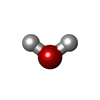 ChemComp-HOH: |
-Experimental details
-Structure determination
| Method | cryo EM |
|---|---|
 Processing Processing | single particle reconstruction |
| Aggregation state | particle |
- Sample preparation
Sample preparation
| Concentration | 1.0 mg/mL |
|---|---|
| Buffer | pH: 7.6 |
| Vitrification | Cryogen name: ETHANE |
- Electron microscopy
Electron microscopy
| Microscope | FEI TITAN KRIOS |
|---|---|
| Image recording | Film or detector model: GATAN K3 (6k x 4k) / Average electron dose: 70.0 e/Å2 |
| Electron beam | Acceleration voltage: 300 kV / Electron source: OTHER |
| Electron optics | Illumination mode: OTHER / Imaging mode: BRIGHT FIELD / Nominal defocus max: 2.5 µm / Nominal defocus min: 1.5 µm |
| Experimental equipment |  Model: Titan Krios / Image courtesy: FEI Company |
 Movie
Movie Controller
Controller











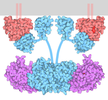



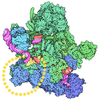
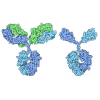
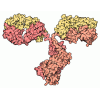



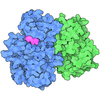
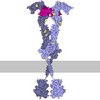
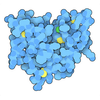

 Z (Sec.)
Z (Sec.) Y (Row.)
Y (Row.) X (Col.)
X (Col.)







